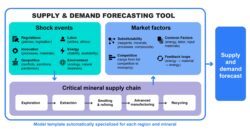DARPA awarded Charles River Analytics a contract totaling $4.5M to create a large-scale probabilistic model of supply and demand, which aims to increase transparency for the global critical minerals market.
Critical minerals, or minerals that are essential for economic and national security but have vulnerable supply chains, such as nickel, cobalt, and lithium, are essential for building jet engines and green technology such as electric vehicle batteries and solar panels. However, pricing and supply and demand forecasts are opaque and variable due to complicated processing steps for different minerals, long timescales (~16 years to build a new mine, according to S&P Global), geopolitical conflicts, and issues with data sources. These factors make it difficult for producers, consumers, and investors to know the economic value and future supply and demand of critical materials. The DARPA Open Price Exploration for National security (OPEN) program seeks technical solutions to transparency issues.
“We are creating a system for better predicting the supply and demand of critical minerals in a probabilistic way,” says Dr. Sanja Cvijic, Senior Scientist and Principal Investigator on Charles River’s effort supporting the DARPA OPEN program.
Software engineers and scientists from Charles River are partnering with European analytics firm Rovjok for critical materials subject matter expertise. The team is using artificial intelligence and machine learning to estimate how certain indicators can help predict regional supply and demand for specific minerals. The forecasting system uses Scruff™, an open-source probabilistic programming framework for developing AI systems. Scruff is particularly well suited for OPEN because it integrates probabilistic models with many different kinds of models, like mathematical, econometric, and machine learned.
The system lets users explore “what-if” scenarios by entering their own assumptions about unknown future outcomes—such as the effects of natural disasters, policy regulations, labor strikes, chemical breakthroughs, or geopolitical events. It then provides tailored supply and demand forecasts based on those inputs to help users make informed, actionable decisions.

“Our Scruff-powered forecasting provides full transparency,” says Cvijic. “Our hope is that the ability to model a variety of future assumptions and their impacts will help stakeholders make strategic and competitive decisions and also empower investors.”
The immediate goal is to provide a forecasting system prototype for critical minerals in four months.
Contact us to learn more about our technology development for OPEN and our other artificial intelligence capabilities.





